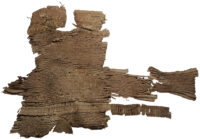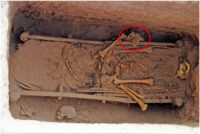 A study of the suit of leather scale armor discovered in Turfan, northwest China, has revealed that it was manufactured in the Neo-Assyrian Empire between the 6th and 8th century B.C., making it the oldest known leather scale armour in Eurasia. It was already a unique find because of the exceptional preservation of the organic materials and its near-completeness, but its origin makes it a very rare example of the movement of technology from West to East across Eurasia in the first half of the first millennium B.C.
A study of the suit of leather scale armor discovered in Turfan, northwest China, has revealed that it was manufactured in the Neo-Assyrian Empire between the 6th and 8th century B.C., making it the oldest known leather scale armour in Eurasia. It was already a unique find because of the exceptional preservation of the organic materials and its near-completeness, but its origin makes it a very rare example of the movement of technology from West to East across Eurasia in the first half of the first millennium B.C.
The armor was found in an excavation of the Yanghai cemetery site in 2013. It was discovered in the tomb of an adult male about 30 years of age who had been buried on a wooden bedstead. Horse cheek pieces found in the grave indicate the deceased was a cavalryman.
 The leather armor was underneath the funerary bed. Deterioration of the leather lining caused some scale loss and separation, so the armor was in two large fragments with a few smaller pieces. A thorn embedded into one of the scales shortly before burial was radiocarbon dated to between 786 and 543 B.C.
The leather armor was underneath the funerary bed. Deterioration of the leather lining caused some scale loss and separation, so the armor was in two large fragments with a few smaller pieces. A thorn embedded into one of the scales shortly before burial was radiocarbon dated to between 786 and 543 B.C.
It was originally made of about 5,444 smaller scales and 140 larger scales, which together with leather laces and lining weighed between 4 and 5kg. The armor resembles a waistcoat that protects the front of the torso, hips, the sides and the lower back of the body. It can be put on quickly without the help of another person and fits people of different statures.
“The armor was professionally produced in large numbers,” says Patrick Wertmann. With the increasing use of chariots in Middle Eastern warfare, a special armor for horsemen was developed from the 9th century BCE. These armors later became part of the standardized equipment of military forces of the Neo-Assyrian Empire, which extended from parts of present-day Iraq to Iran, Syria, Turkey and Egypt.
While there is no direct parallel to the 2,700-year-old armor in the whole of Northwest China, there are some stylistic and functional similarities to a second contemporary armor of unknown origin held by the Metropolitan Museum of Art in New York (the Met). It is possible that the two armors were intended as outfits for distinct units of the same army, i.e. the Yanghai armor for cavalry and the armor in the Met for infantry.
It is unclear whether the Yanghai armor belonged to a foreign soldier working for the Assyrian forces who brought it back home with him, or whether the armor was captured from someone else who had been to the region.
There are cuneiform tablets recording the production of leather scale armor, but none has ever been found before in Mesopotamia. The only complete set of leather scale was discovered in the tomb of Tutankhamun in 1922, but it was so fragile only a few scales could be studied. This find could be studied in detail, each scale counted and examined to explore its construction.
The study has been published in the journal Quaternary International and can be read in its entirety here.